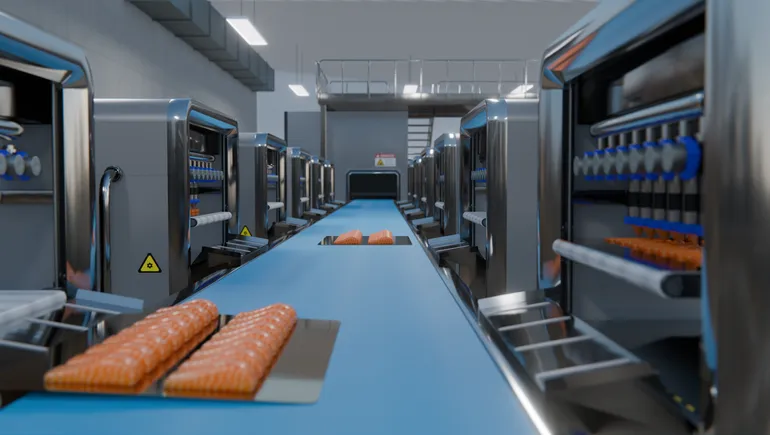To farm or fabricate? 3D printing’s role in the food industry

3D printing has taken much of the manufacturing world by storm — and the food industry could be up next.
Manufacturers across the aerospace, automotive and energy industries are working to boost adoption of additive manufacturing among their suppliers and in their factories for its ability to alleviate supply shortages and enhance product customization. Motivated by the technology’s potential benefits, Robin Simsa embarked on his journey to establish Austria-based seafood startup Revo Foods in 2020.
While working on his doctorate in cultivated meat, Simsa discovered an additive technology that could integrate a fat component into plant protein fibers to create more realistic meat alternatives.
“As often in startups, you have a new finding, you figure out there’s no industrial way to do it, and then you’re foolish enough to start it yourself,” the CEO said.
Revo Foods’ first product — 3D-printed salmon fillets — hit Austrian supermarkets last September, the first 3D-printed food to ever be sold in grocery stores, according to the company. The startup already plans to scale production with its multi-nozzle system, which combines multiple print heads within a single piece of production machinery.
Revo Foods uses extrusion to manufacture its alternative seafood products, a common 3D printing process in which a material is squeezed through a nozzle in successive layers to recreate an object from a digital file. The startup’s patented food printing technology lets it precisely combine its plant-based protein and fat ingredients, making its final products more authentic in terms of cooking and mouthfeel, Simsa said.

Revo Foods is using its 3D printing technology to produce salmon fillets.
Permission granted by Revo Foods
One of the earliest things the startup focused on achieving was a continuous extrusion process. “Normally, this is a batch process, and it’s very hard to think in terms of scale,” Simsa noted.
Although companies like Revo Foods are advancing in the realm of 3D-printed food, scalability remains a significant challenge.
“The largest obstacle for 3D printing to overcome is throughput,” said Edwin Palang, senior commercialization manager for food R&D firm Mattson. “When we talk to co-manufacturers, the first thing they ask [about] right away is volume.”
Palang underscored the efficiency gap between the technology and traditional food production methods, for example when making a hamburger patty. The quickest he had observed a 3D patty get formed was in about two minutes, whereas conventional processes can churn out about 130 patties in that time.
However, Palang still believes 3D printing could have a place in the food industry, mainly for high-end products. This includes items that require complex shapes that traditional manufacturing can’t deliver, such as alternative premium meat cuts and highly marbled fish fillets.
“The benefit of 3D printing here extends beyond customization; it supports the creation of sustainable, alternative protein sources that closely replicate the taste and texture of high-end meats and seafood,” he said.
Consumer demand for seafood has skyrocketed in recent decades, with more than a third of global fish stocks overfished as of 2019, according to the United Nations. Revo Foods aims its product portfolio at bridging this gap, and it is not the only company to do so.
Since December, Israel-based food tech company Steakholder Foods has unveiled two 3D-printed seafood products: eel and shrimp. The $4.3 billion eel market faces severe challenges like overexploitation and the threat of extinction, the company said in a press release, emphasizing the need for sustainable alternatives as demand continues to grow.
In a statement, CEO Arik Kaufman touted the company’s patented printing technology’s ability to reproduce the intricate texture of an eel on a potential scale of hundreds of tons a month at lower costs than harvesting wild eel. The CEO also highlighted the process’ flexibility to make a range of printed products using the same production line.
It’s a really awesome technology, but the thought that it’s going to take over and be equivalent to regular meat production is hard to imagine at this point.”

Jaime Reeves
EVP of Product Development and Commercialization, Mattson
As of now, however, Mattson’s EVP of Product Development and Commercialization Jaime Reeves said companies exploring 3D-printed food are focusing on products that already have a premium price point.
“It’s a really awesome technology, but the thought that it’s going to take over and be equivalent to regular meat production is hard to imagine at this point, from what we’ve seen and the people we’ve talked to in the industry,” Reeves said.
Still, Purdue Professor of Mechanical Engineering Ajay Malshe believes 3D-printed food could be scaled within the next decade.
“Additive manufacturing technology is, in my mind, at a commercial level for metals and polymers,” Malshe said. “A lot of those equipment design know-hows are being repurposed in the food industry.”
He suggested that incentives for food producers to adopt the technology could transcend the high-end market.
Using 3D printing, food producers could tailor the typically large footprint of their manufacturing plants to bring production closer to consumers by creating custom, modular food manufacturing platforms. These would lower transportation costs and have the potential benefit of using local resources to create products, according to Malshe.
He also highlighted shifting consumer preferences as another driving force, particularly as younger generations become increasingly aware of the origin and quality of their purchases.
“The ‘where my food comes from,’ people do want to know that – they want the traceability of that,” Malshe said.
Source: fooddive.com

